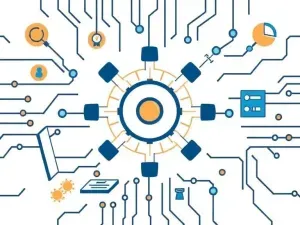In today's dynamic business environment, efficient project management is fundamental to success. Odoo's Projects module presents itself as a comprehensive solution for planning, executing, and controlling projects, optimizing collaboration and increasing productivity. This article explores in detail the features, benefits, and applications of Odoo Projects, aimed at project managers, development teams, agencies, and companies looking for a robust tool for managing their initiatives.
What is Odoo Projects and How Does it Fit into the Odoo Ecosystem?
Odoo Projects is the native project management module within the Odoo suite of applications. Unlike standalone solutions, Projects is designed to integrate seamlessly with other key Odoo modules, creating a continuous and efficient workflow.
- Integration with Sales: Projects can be created directly from sales opportunities, ensuring a smooth transition from the quotation phase to project execution. This allows for precise tracking of project costs and profitability from the beginning.
- Integration with Timesheets: The Timesheets module allows team members to record the hours dedicated to each project task. This information is used for cost control, billing, and productivity analysis.
- Integration with Invoicing: Once a project or a phase of it is completed, it is possible to generate invoices directly from the Projects module, based on the hours worked, associated costs, and the original contract.
- Integration with Accounting: The financial information generated in Projects flows directly to accounting, providing a complete view of the company's financial health.
- Integration with Inventory and Purchases: If a project requires specific materials or resources, purchase requests and inventory can be managed directly from the project sheet.
- Integrated Communication: Through integration with Odoo's Messaging module, project-related communication is centralized, strengthening collaboration.
This holistic integration is one of the main advantages of Odoo Projects over other project management tools, eliminating the need to switch between different platforms and reducing the risk of errors and delays.
An Overview of the Interface and Functionalities
Odoo Projects offers a visually intuitive and easy-to-use interface, designed to facilitate daily project management. Two of the main views are Kanban boards and timelines, complemented by the hierarchical task structure.
Kanban Boards
Kanban boards visually represent the project workflow, dividing tasks into columns that represent different stages (To Do, In Progress, Verification, Done, etc.).
- Drag and Drop: Tasks can be easily moved between columns by dragging and dropping them, automatically updating their status.
- Clear Visualization: Each task card displays crucial information such as the title, assignee, due date, and tags.
- Customization: The columns of the Kanban board can be customized to reflect the specific workflow of each project.
- Subtasks: Each task can have subtasks, allowing for a detailed breakdown of activities.
Timelines (Gantt Charts)
The timeline view offers a graphical representation of the project plan, showing tasks based on their start date and duration.
- Dependencies: Dependencies between tasks can be defined, ensuring they are completed in the correct order.
- Critical Path: The timeline helps identify the critical path of the project, that is, the sequence of tasks that, if delayed, will affect the project's completion date.
- Resource Allocation: Resource allocation to each task can be visualized, avoiding workload overload.
- Dynamic Adjustments: The timeline allows for quick adjustments to the project plan in response to unforeseen changes.
Hierarchical Tasks
Odoo Projects allows the creation of a hierarchical task structure, with main tasks broken down into subtasks and sub-subtasks, to the level of detail required.
- Organization: Facilitates the organization of complex projects.
- Responsibility Assignment: Allows assigning different assignees to each level of the hierarchy.
- Detailed Tracking: Provides detailed tracking of progress at each level.
- Progress Roll-up: The progress of subtasks is automatically reflected in the main tasks, providing a consolidated view of project progress.
Key Features of Odoo Projects
Odoo Projects offers a wide range of features designed to optimize project management at all stages.
- Task Management:
- Creation of tasks with description, priority, tags, and attachments.
- Assigning responsible parties and due dates.
- Defining dependencies between tasks.
- Tracking the progress of each task.
- Time Tracking:
- Recording hours worked per task.
- Generating productivity reports per team member.
- Analyzing the labor costs of the project.
- Budget Management:
- Creating detailed budgets for each project.
- Tracking actual costs against the planned budget.
- Overcost alerts.
- Collaboration and Communication:
- Integrated chat to facilitate communication between team members.
- Automatic notifications about task updates and comments.
- Sharing documents and files directly in tasks.
- Customer portal for limited access to project information.
- Reporting and Analytics:
- Project progress reports.
- Team productivity reports.
- Project cost and profitability reports.
- Risk and issue analysis.
- Automation:
- Automation rules to assign tasks, send notifications, or update statuses.
- Integration with other Odoo modules to automate workflows.
Benefits of Implementing Odoo Projects
Adopting Odoo Projects can generate numerous benefits for businesses.
- Improved Project Delivery: More accurate planning and tracking allow projects to be delivered on time and within budget.
- Reduced Forgotten Tasks: The clear structure and automatic reminders minimize the risk of pending or unattended tasks.
- Real-Time Progress Visibility: Kanban boards, timelines, and reports provide a clear view of project progress at any time.
- Greater Collaboration and Communication: The integrated chat and automatic notifications facilitate communication between team members and clients.
- Cost Reduction: Time tracking and budget management help optimize project costs.
- Increased Productivity: Automation of tasks and elimination of manual tasks free up time for team members to focus on higher-value activities.
- Improved Customer Satisfaction: Better project management leads to greater customer satisfaction.
Practical Example: Developing a New Mobile Application
Consider the case of a software development agency undertaking the development of a new mobile application for a client.
- Project Creation: A new project is created in Odoo Projects, linking it to the corresponding sales opportunity.
- Phase Definition: The project is divided into main phases: Design, Development, Testing, Deployment.
- Task Creation: Each phase is broken down into specific tasks: User interface design, Backend development, Unit testing, etc.
- Assignee Assignment: Assignees are assigned to each task, indicating their due dates.
- Progress Tracking: The team uses the Kanban board to move tasks through the different stages, updating progress in real time.
- Time Tracking: Developers record the hours dedicated to each task using the Timesheets module.
- Communication: The team uses the integrated chat to discuss issues and share ideas.
- Reporting: Periodic reports are generated to inform the client about project progress and incurred costs.
- Invoicing: Once the project is completed, the invoice is automatically generated based on the hours worked and the terms of the contract.
Odoo Projects vs. The Competition: Asana, Trello, Jira
While there are numerous project management tools on the market, Odoo Projects stands out due to its integration with a complete ecosystem of business applications.
- Asana: Asana is a popular tool for task and project management, known for its flexibility and ease of use. However, it lacks the deep integration with other business modules that Odoo offers.
- Trello: Trello is a visual tool based on Kanban boards, ideal for simple projects and small teams. Its functionality is limited compared to Odoo Projects, especially in regard to budget management and time tracking.
- Jira: Jira is a robust tool designed primarily for software development teams, with a focus on bug tracking and issue management. Its complexity can be overwhelming for projects not related to software development.
Odoo Projects offers a balance between functionality, flexibility, and integration, making it an attractive option for companies of all sizes.
Next Steps
Evaluate your current project management needs and identify the challenges your team faces. Explore the possibility of a demonstration of Odoo Projects to understand how it can optimize your processes and improve productivity. Start organizing your projects in a more intuitive and efficient way, benefiting from the power of integration.






